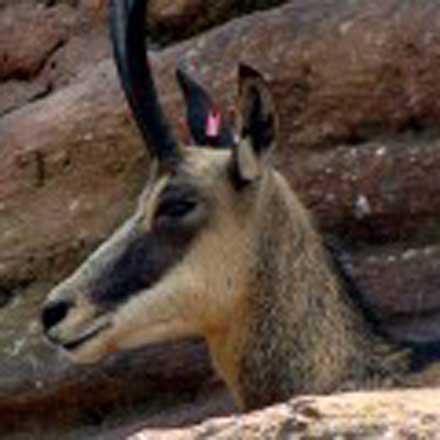
North America, we have the very distinctive Rocky Mountain goat that has long white hair and black horns that curve back slightly. While in Europe, a close relative is called the chamois (pronounced:
shammy), a somewhat smaller goat that is a rich brown color in the summer turning to a light grey in winter. It has contrasting black and white portions on its face, a white rump, and a black stripe along its back. The straightish horns are proportionally sized in comparison to the Rocky Mountain goat, but the ends of a chamois’ horns hook backwards near the tips. They average around 30” tall, and a large male can weigh up to 130 lbs., less than half what a large, fully grown Rocky Mountain goat might weigh. Both are extremely sure-footed and are well suited to living up above the tree line in mountain areas. One fall when visiting my friend in Steyr, Austria, he casually asked if I would like to go on a chamois hunt in the western Tyrolean Alps. Count me in!
Chapter 1: Alpine Adventure
Fortunately, I had along appropriate hunting clothes and most importantly, correct hunting boots suitable for mountain climbing. Thomas would let me use his rifle, a new Steyr ProHunter in 7mm Rem Mag. which was already sighted in at 250 meters using 140 grain Nosler Partitions. He said we would be hunting about three or four hours west of Steyr and would be joined by his friend who would meet us up the mountain at the small chalet we will be using as a base camp. We left early the next morning and made it to the base of the mountain area we would be hunting by 10 a.m. We parked next to his friend’s vehicle who had arrived the day before. Thomas said we had about a two hour climb to get to the chalet. He kept using that term- chalet- and I really had no idea what exactly that meant. I did not expect much for quarters when it is up high near the edge of the tree line. How could you ever get anything substantial up so high? Oh well… in about two hours, I would know.
We were at the base of the valley with the incline up the mountain beginning literally right next to our vehicles. There was no gradual rolling hills area but only an immediate incline. Thomas took off leading the way. Looking up above, it looked like we were going to, in essence, be doing a stair climber exercise machine for two hours! Before me was a rock strewn incline of at least 30 degrees with nary a flat spot or gentle meadow. Rather than...
looking up and getting depressed, I just focused on Thomas’ boots where he placed them. That would be my goal the whole way up- only look where his boots were and step to the same spot with each uphill step I took. I was an “office guy” from America trying to keep up with an Austria goat! Man, could Thomas ever climb and apparently never need to stop for a rest. Having had minor knee surgery the year before, my legs were doing fine, but my lungs ached for air. After about a half hour, I told him I must take a five minute break. I was sweating buckets and breathing hard/wheezing for air. He had hardly broken a sweat yet and was breathing normally like he had been doing light yard work for the past half hour. Not to worry, he said. He and Robert go up here at least twice a month just to get away, so their legs and lungs are pretty used to this.
After about a half hour I told him I must take a five minute break. I was sweating buckets and breathing hard/wheezing for air- he had hardly broken sweat yet, and was breathing normally like he had been doing light yard work for the past half hour. Not to worry he says, as he and Robert go up here at least twice a month just to get away, so their legs and lungs are pretty used to this.
By the two hour mark, the trees thinned considerably, and above us we could see open meadow of just grass, and rock strewn slopes above that up to the bare rock face of the mountains
Robert? Alpine marmot hunt Robert? Yes, it turns out the friend already at the chalet was Robert, the physical therapist who had guided me on a marmot hunt the year before. How good it would be to see him again and to hunt with him in the mountains. As Thomas and I ascended, the trees were so thick I could not see more than 50 yards ahead, or to either side, but of course, when I turned around I could see down into the valley where we had parked. Finally, after an hour and a half, the trees started to thin out, and we could see up the mountain just a bit. By the two hour mark, the trees thinned considerably, and above us, we could see open meadow of just grass and rock strewn slopes above that up to the bare rock face of the mountains. As we crested a rise, the chalet came into view. It was a very old log cabin, perhaps only 8 x 12 feet, with a low roof covered in soil. There was grass and moss growing on top, giving it a very aged look. There was a little split...
rail fence around the sides and the front below, but the backside of the chalet was dug back into the mountainside. A small, smoky fire was burning outside, and there sat Robert smiling as we walked the last few steps to our home for the next few days.
Chapter 2: Afternoon Scouting
After a relaxing lunch, Thomas, Robert ,and I set off to begin scouting around. They assured me the area contained many chamois, but the important thing was to find a fully mature, older bull past his breeding time. While the females and young stay together in herds, the older males tend to be loners. We had barely gone fifteen minutes to the east when my friends both throw up their binoculars and claim to see six, no eight chamois up above us 500 to 600 meters distant in an open rock field. I look and look, but at first cannot even see one! Late in the fall, they are transitioning from their brown
coats to light grey. In either case, to my eyes, all I could see is rocks. I kept looking and looking and saw nothing. Thomas called out two does each with a young kid, Robert saw several one to two year old chamois. I still could see nothing, and began to think they were pulling my leg. They started calling out reference points up above, and eventually, I finally could make a few of them out. Feeling so foolish though, I stated that yes, I could see them all now, but began to wonder how I would harvest something I could not even see?
The terrain is unbelievable, as at a minimum we were walking on slopes of at least 30 degrees, and at times, I swear it grows to 45% or steeper. We drifted in and out of the tree line, fortunately not having to make big climbs anymore. We were already way up the mountain.
They assured me the area contained many chamois, but the important thing was to find a fully mature, older bull past his breeding time
Mostly, we covered distance by just maintaining our elevation, but the steep slope caused problems. At times my downhill boot was a foot below the other. I could use the buttstock of my rifle like a walking stick to brace myself on my uphill side as I hiked, but there was no way I could even reach the ground if I held my rifle to the downhill side. As long as I could barely see the chamois at all, I left the animal gazing to them. Instead I focused 100% on where I exactly needed to place each foot, so I didn’t slip and start...
rolling down the steep slope to a certain death.
This is no exaggeration at all. I truly was fearful for my life. Being above the tree line, there were no bushes or trees to stop my swift downhill descent should I slip and begin to tumble. I would roll and roll downhill like a tumbleweed, breaking bones and incurring horrific cuts all over my body from the sharp edged rocks I was speeding over. Hopefully, after two or three hundred meters of this tumbling, I might run into some vegetation to slow me down a bit and not come to an abrupt stop by impacting a large rock, or worse yet, shoot off a ledge or drop off only to crash land on more rocks.
Each time we pause for them to glass up above for game, my mind sighs in relief
So the rest of the day continued on with Thomas and Robert scouting for a nice chamois bull, and I having to determine exactly where each boot would be placed with every step I made, so I would not die as a result of a bad fall. Both my friends seemed oblivious to the danger and had conditioned their feet for placement. They had conditioned their legs and lungs to function so well above the tree line. Each time we paused for them to glass up above for game, my mind sighed in relief. It could stop having to make life-or-death decisions with every step. I was not having fun.
Finally we stopped our eastward march. We had come to the upper edge of a huge avalanche bowl where the winter snows had carved out all vegetation and left a steep, sloped, concave surface riddled with loose rock. Amen. Turning around, we headed back to the chalet. This time ,my right foot placed well above my left with each step I took. My body had to relearn how to walk on steep slopes again, but it was somewhat easier as I had some practice on the way out. I was so relieved to be back at the chalet and sit down to have the evening meal. While my friends talked about the afternoon hike and where we needed to go tomorrow, I felt truly blessed to have cheated death so many times during our walk. As I lay down in my sleeping bag that night, I prayed that I could get my chamois tomorrow. I did not think my mind could handle three or four days of hiking such extremely steep slopes.
Chapter 3: Day Two-Much Worse
Imagine you are standing at the goal post at one end of a football field, when suddenly the far left edge is raised 100-feet,...
putting the entire field at a 35 to 45 degree slope. Now imagine you have to walk the full length of the sloping field, back and forth, goalpost to goalpost, for eight or ten hours. Oh, and when you begin in the very early morning, it is below freezing, the grass has heavy frost on it, and it is fully shaded for the first hour. When the sun finally hits it, the frost begins to melt, leaving you to walk on wet grass for at least another two hours. From mid-day to late afternoon, the grass is actually dry, but you have been walking along that steep slope for six to eight hours. Then as the sun drops below the horizon, and the air starts to cool to below the dew point, the grass gets wet again. Add in large areas of loose rocks, and undercut a 50-foot deep trench all along the low, right side of the field, and you would have a very good idea of what my second day of hunting was like. I was not looking forward to the third day.
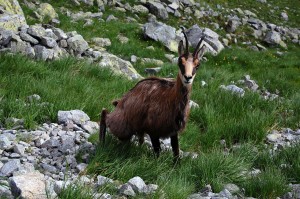
Chapter 4: Day Three
We left early in the morning, this time heading west where the terrain was less steep. While it was a very welcome break, I still was not at ease. I continued looking at the ground with each step I took to ensure safe footing. Finally, by mid-morning when we stopped to take a break, I was able to fully appreciate the great beauty that surrounded me in the Alps. We were in a grassy meadow, with spectacular views in every direction. I could see across several mountain ridges away in the distance and clearly saw where the tree line traced itself around and around at the same elevation. No cars, no planes, no towns below. We had no radio, and cell phones didn’t work out here either. All we
had was the sun shining down on the forests below and the mountains above and crisp clear air to suck into our lungs with every step we took. It was unbelievably quiet and peaceful. We decided to head back to the chalet for lunch and plan for the afternoon hunt.
Finishing his meal, Robert stood up and pointed to the east, “I think we should work our way slowly to the large bowl, at a higher elevation to reach the western edge of the bowl near the center.” Thomas nodded in agreement, as did I, but inside I did not look forward to revisiting the...
site we hiked to the first afternoon, because this time I knew the steepness of the terrain I’d have to face again.
No cars, no planes, no towns below. We have no radio, and cell phones don’t work out here either
We gathered up our gear, Thomas taking his backup .243, and Robert an identical twin of the 7mm I was carrying of Thomas’. Fortunately, we moved at a slightly slower pace as my friends were really taking the time to carefully glass the areas above. We did see several chamois all along, but nothing that would be considered a suitable trophy. Around 2:30 in the afternoon, we finally made it to the bowl.
Imagine having a huge cereal bowl, almost a mile across and perhaps 300 yards deep. Now tip it to the south about 30 degrees, and rim it with jagged mountain tops to the east and north. That is what we saw as we approached it from the west, on the side of the mountain. We were on a sloped edge, basically the rim of the bowl, which had to be at a 45 degree slope or greater. We could hardly stand up without sliding down. As we moved closer to the edge, we had to go down on all fours because the ground was covered with loose rock and very steep. I let Thomas and Robert approach the edge. They began to scan with their binoculars, while I was very contented to be on all fours, clinging to the side of the slope. They saw several females with young kids, and then finally, exclaimed that there was a fine old male down in the western corner of the bowl. They hurriedly waved me over, Robert climbing up above me, while Thomas dropped down below, both within six feet of me. I got near the edge, but could not see the male.
“Ken you have to get to the very edge to see him, as he is in the very corner of the bowl, hard to the left. He is about a hundred and fifty meters below us, and about two-fifty distant.”
I was lying on my belly and slowly inched eastward to the very edge of the bowl. With the high mountain ridge, the western quarter of the bowl was in the shade already, and I spotted him just inside the shade perhaps 50 meters or so. As they said, he was every bit of 250 meters distant in the one o’clock position, but he was down in the bowl around 150 meters lower in elevation. He was slowly feeding on what I don’t know, and the ground under him appeared to be shattered rock and gravel, debris from countless avalanches over hundreds of years....
It was so steep where I lay prone, that my feet were at least four feet below my head, and I couldn’t stay put. Three times I tried to settle in, but each time I would slowly slid a foot or more down the slope. I belly crawled up and immediately tried to dig the toes of my boots into the slippery rock. Finally, I stayed put.
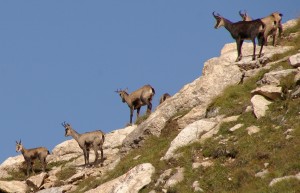
My right elbow had to be on the very edge of the cliff, the west rim of the bowl, because if I moved away to my left for a safer perch on the edge, the chamois went out of view. Below me to the south, there were loose rocks for about 100 meters, and then a shear drop off; how far down I did not want to know. Each time I settled in to take a shot, my right elbow slipped off the edge of the cliff. When I looked eastward to my right, I was looking down a drop off slope of 70 to 80 degrees for at least 100 meters down into the bowl. It was a very precarious place from which to shoot, but I had no choice. My friends kept telling me to take the shot.
“Guys, if I shoot him down there, I’ll never be able to retrieve him. I see no way to get to him, and how in the world would I ever get him up out of there?”
Almost in unison they replied back, “You shoot him, and we will retrieve him. Now shoot!”
I fired; he dropped and rolled maybe 20 meters down the loose rocks, lying motionless when he stopped. I truly felt as if I had cheated death from that precarious perch on the rim of the bowl. There were only brief congratulations, and then Thomas and Robert said they had to retrieve the chamois right away to get back before sunset. It was not the kind of terrain I wanted to be carrying a load through in the dark. With the trophy they would have to carry, and the treacherous terrain they had to cover, they both left their rifles and backpacks with me to carry back to the chalet. They bid me farewell, and headed down the mountain with only their knives on their belts. The only way they could get to my trophy was to go to the bottom of the bowl, and then work their way up the middle of it, and then head west to the chamois. It scared and amazed me what they were willing to do for a friend....
Goats that they are, they headed down the steep slope and disappeared over the drop off in just a few minutes. I was left standing on the steep slope with three rifles and three backpacks, wondering how I would carry all of this gear without stumbling and rolling down the mountain to an almost certain death.
suddenly my right foot slips out, but fortunately I fall uphill and lay there with my heart pounding…
Chapter 5: Careful Trip Back
I placed one rifle and one backpack over my left shoulder. My backpack was already on my back. The second rifle and third backpack got slung onto my right shoulder. As I headed west, my right leg was uphill, so I had to carry the third rifle loose in my fight hand by the barrel to act as a walking stick. I had to lean uphill to keep from falling downhill. I looked like one of the one-man-bands with things hung and sticking out everywhere. Keep in mind I was on a 45 degree slope and there was no distinct trail to follow at all. In just a few steps I felt like I was going over. All of the gear on my back and shoulders had made me top heavy. I started to walk. Suddenly my right foot slipped out, but fortunately I fell uphill and lay there with my heart pounding, looking very much like a beached whale. I worried briefly about scratching the scopes or rifles, but then I was just thankful I wasn't rolling down the mountain! There had to be a better way to do this; maybe not easier, but at least safer.
I was fearful walking with just my own rifle and backpack. Tripling my load scared the hell out of me after my first fall. The only way I could see to get safely back to the chalet was to carry two rifles and one backpack about 50 meters across the slope. I would set them down and then walk back empty handed for the other two backpacks and one rifle. My first effort went well, but I quickly realized the process would triple the time and distance to get back to the chalet. 50 meters to the west with half the load, then 50 back east to pick up the other half, then 50 to the point where I had set my first load. This meant I had traveled a total of 150 meters on a steep slope to get all the gear only 50 meters nearer the chalet. If I was lucky, I would make it back by dark. Psychologically, what I did to make me feel better was with my second half of each load, I would keep walking another 50 meters past where I had set...
the first load, then go back and get the first load 50 meters to the east. This resulted in my westbound trips covering 100 meters and having to go back only 50 to the east to gather up my prior dropped load.
They had gotten to the chalet an hour and a half ago!
I continued westward, maintaining my elevation, knowing that as I neared the chalet, I would have to drop down some. Wondering how Thomas and Robert were doing, I was unsure who might get back first. As I was finally nearing the chalet, it was already quite dark, and I had my answer; a lantern was burning on the outside table, and a nice campfire was heating up dinner. My friends gave me a warm greeting and said they were just about to head out to the east, to see what had happened to me. When I explained how I had to travel, and that it took me three times as long to keep doubling back, they roared with laughter. They had gotten to the chalet an hour and a half earlier! As long as they had to get out of the bowl at the bottom, they just took a lower direct beeline to the west, and then hiked up with the chamois to the edge of the tree line and found the chalet in the fading light.
Glancing over at my chamois which was hung on the side of the cabin, they said it was an unusual trophy, and they needed to show me something. On the tip of the left horn was a slight deformity. It looked like a bit of wax had dripped down the tip of the horn and hardened in the distinct shape of a duck! I could clearly see the bill, the head and neck, and the body with tail, all in profile. It was only around an eighth of an inch tall and maybe a quarter inch long, but there it was as clear as could be. It looked like a miniature duck decoy was hanging from the tip of the antler! They explained that as a young buck, when the horns were just beginning to develop, he must have damaged the live tip. Amazingly, the little growth had somehow stayed on its whole life. They aged him by counting the growth rings on his horns to be at least twelve year old. Robert carefully placed the “last meal” in my chamois’ mouth, a bit of grass to show respect for the trophy taken before we sat down to eat a well-deserved meal.
Chapter 6: Chamois On My Shoulders
Early the next morning after a good breakfast, we cleaned up the camp and assembled all the gear for the trip down the mountain. My friends surprisingly...
offered to carry my chamois down to the vehicles, but I told them it is a task a hunter must do with his own trophy. Having only been field dressed, he still probably weighed around eighty lbs. They raised him up onto my shoulders from behind; his head to my left and the front and rear legs resting on top of my shoulders, pointing forward. I raised my left arm and grabbed his front legs just above the hooves and his hind legs the same way with my right hand. His chest was against the back of my neck, and he actually felt quite stable in that position. Thomas grabbed his rifle he had loaned me for the hunt, and Robert my backpack, as we began the trip down to the valley.
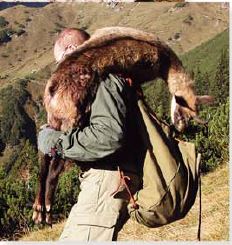
While going up was hard on my lungs and legs, I soon found out that going down- especially with a good load on my shoulders- was hard on my knees and my toes. This was so because at best, I was working hard to do a controlled fall down the slope, for as soon as I raised your leg and swung it forward, my knees had to absorb the shock of the forward fall and descent. And each step downhill caused the end of my toes to mash against the inside of my boots, making for very tender toenails in short order. Those parts of me got real sore, real fast, and much later, I ended up losing two toe nails from the trauma to them.
Several times during the descent, both Robert and Thomas offered to carry my chamois for a while, but this was something I had to do for myself. I only stopped once the entire trip down and dared not take the trophy off my shoulders fearing I could not get myself to put it back up there. When I came to a very large, thigh-high rock about half way down, I stood downhill of it and sat back somewhat on it to give my knees and toes a break, but I kept the chamois on my back the whole time. The greatest challenge was to keep from moving too fast downhill, but that was difficult at times, and we often had to descend down a washout area with only loose rocks on the slope. When I tried to make my legs rigid so they would not slip out from under me, much like when walking on ice, as soon as my boot touched the loose rock, I would start to slip and slide downhill in an uncontrolled fashion. This scared the...
heck out of me! So I tried zig-zagging left to right down the loose rock sections, but I still had my feet shoot out from under me, landing on my rump with the chamois still on my shoulders. In desperation, I asked Thomas what I should do. How do I safely descend loose rock?
“You won’t believe it Ken, but you need to run down the loose sections, and slow down only when you get to firm ground!”
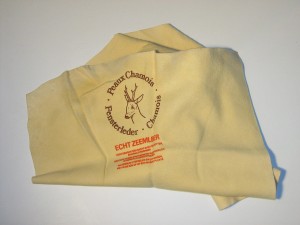
So I tried it, and his method worked like a charm but was scary as all get out the first few times!
Finally, after descending the steep mountain for one and a half hours, we came to the grassy valley floor below with the vehicles in clear sight. I walked right up to Thomas’ vehicle and swung the chamois off my back to the ground. It felt funny when the blood rushed back into the muscles on the top of my shoulders, and my arms were happy to hang limp at my sides. Both Robert and Thomas walked up and congratulated me for not giving up, carrying my trophy the entire way down by myself, and for never taking him off my shoulders. Robert said it was especially good for an “office boy” since he knew I basically had a desk job, and did not run up and down mountains like he and Thomas did several times a month.
As we loaded our gear and the chamois into the vehicles, I smiled thinking about all I had accomplished. Honestly, truly, I was in a constant state of fear whenever we would traverse the extremely steep slopes because a slip, trip, or fall would have seen me rapidly rolling down jagged rocks, with a good possibility of then free falling off a rock edge below. It would take a whole lot of hiking in the mountains for me to even begin to feel as comfortable as my two good friends did up there. Following the twisty valley road out about five miles out towards town, Thomas pulled over and said we needed to get out. He wanted to show me something.
Pointing high up above, and back from where we just came, he stated, “Ken, you see that large treeless, rock strewn bowl just below the highest peak? In that bowl is where you harvested your special trophy, and the far left rim of the bowl is from where you took the shot. You did well as a hunter and should be very proud.” I gave him...
a big hug and thanked him for all of his efforts to make my once-in-a-lifetime hunt an experience I will never forget. While this story may seem over, it is not, for we have yet to make it to the town at the base of the mountain and visit with some very important people.
“Gud shot,” is all he softly speaks
Chapter 7: Waidmannsheil, und Waidmannsdank
As we pulled into town, Thomas told me that we had to stop by a gentleman’s home who is the man responsible for overseeing all game taken in the area. Every game animal harvested must be examined by him. He keeps records of all trophies taken. As we pulled into his driveway, he was already waiting there. Thomas had called ahead to let him know we were coming.
Now, in the US if someone pulled up to a friend’s house with a big deer or elk in the back of the pickup, that friend would be laughing and high-fiving, and carrying on all loud and boisterous behavior. It would be a loud and vocal time of celebration and compliments. Things are different in Austria. We stopped the vehicle, got out and were approached by the elderly gentleman. He had on Tyrolean hunting clothes, looking like he was ready to go to the field. I was formally introduced to Manfred, and we shook hands. There was not a smidgen of emotion or excitement on his face. Walking around the back, Thomas dropped the tailgate, and pulled my chamois out, carefully supporting the head. The gentleman slipped his hands under Thomas’, who then stepped back. Not a word has been spoken.
Carefully, he examined the body first and saw the entry hole just behind the right shoulder. “Gud shot,” was all he softly spoke. He continued examining the body, the hooves, and finally worked his way up the neck and then to the head. He was treating the animal like he had raised it from a kid, and that he had very strong feelings for it. He
tenderly cradled the head and slowly, respectfully, turned it side to side. He then noticed the small deformity on the end of the left horn, leaning in slowly to carefully examine it from many angles. I had never seen such gentleness shown to a trophy before in my life. I was starting to get a little emotional.
...
Waidmannsheil” he loudly proclaims...as he turns to me and shakes my hand
“Waidmannsheil!” he loudly proclaimed (pronounced: Vide- mans-hile) as he turned to me and shook my hand; that means hunter’s salute or hunter’s luck, a respectful way of acknowledging the hunter’s success
“Waidmannsdank” I reply, as Thomas has taught me; which loosely means the hunter’s thanks, in appreciation of the well-wisher’s recognition of your achievement.
“That is a very rare trophy. This buck is twelve and a half years old, and the small figure on the end of his left horn was caused when he was very young and his horns were just beginning to develop. It looks exactly like a wood carving of a duck! It is so delicate, barely hanging on the end of his horn; it’s amazing it was never knocked off. Such a thing is extremely rare, and you should be very proud of your chamois!”
“Now we must toast!” He went over to an outside table where three shot glasses were sitting next to a bottle of schnapps. I am not really a drinker, but did not refuse as he poured them all and handed them out. Both Manfred and Thomas raised their glasses together, and say in unison, “Waidmannsheil!”
“Waidmannsdank” I again reply. We have one more shot, and then Thomas announces we must show the trophy to more people. Manfred shakes my hand again and we drive off just a short distance to another beautiful Alpine home. Virtually all the same actions and words are said. Praise is given by the Austrian to the unusual trophy. Again the schnapps comes out, and again we drink, then on to several more houses, repeating the process over and over again. I am starving, and do not do well with liquor on an empty stomach as I am an “easy” drunk. But I clearly sense this is something we must do for Thomas, and for the chamois. I can clearly see that he too is very proud of the trophy we have taken, and its uniqueness is drawing much attention and praise from the other fellow hunters.
Finally, I convinced Thomas that we had to get some food in us, so we headed to a local beer haus. The owner of the establishment, a good fried of Thomas', personally seated us. We were still in our hunting clothes, so of course the gentleman asked us if we had been hunting, and what the outcome was. Thomas politely excused...
himself to me in English, saying he needed to speak German to his friend.
Thomas’ eye lit up, and his voice quickened as he jabbered in German, obviously giving him the long version of our successful hunt. He was using strong hand gestures during his description, and I could tell when he started to describe the unusual growth that looks just like a carved duck. The owner leaned back smiling and loudly declared in English, “I must see such a trophy!”
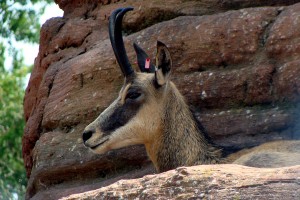
So we all headed outside, Thomas opened the vehicle, and the same gentle examination of the chamois happened all over again. Afterwards I was congratulated again as before, and as we walked back into his restaurant he exclaimed, “Now we must salute you with a drink!” I forced down the 7th or 8th shot of schnapps I have had in just over an
hour. Though the liquor did not sit well with me, I truly feel blessed to have experienced such an incredible adventure with my good friends in Austria and for meeting many fellow hunters who carefully showed me how one should pay great respect to the game we were fortunate to harvest. I was deeply moved by all of these new things. It had stirred in me even more respect for the animals that I have given their “last meal.”